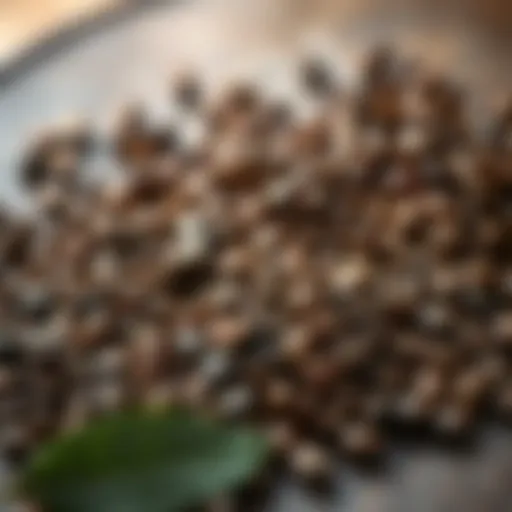Mastering Leg of Lamb Steaks: Cooking Techniques and Pairings


Intro
Leg of lamb steaks are often an underappreciated gem in the world of culinary delights. While lamb has maintained its regal place in many cuisines, the leg cut in steak form offers versatility and depth of flavor that dishes like the classic roast simply can't showcase. This article strives to deepen your appreciation for leg of lamb steaks, guiding you through the intricacies of preparation and cooking, alongside sides and wine pairings that will elevate your meals.
Now, let’s roll up our sleeves and dive into the ingredients that bring these succulent steaks to life.
Ingredients Breakdown
Primary Ingredients
- Leg of Lamb: Look for well-marbled cuts, as the fat will keep the steak juicy during cooking. Freshness is key, so aim to source from local butchers if possible.
- Salt and Pepper: The basics, but vital in bringing out the richness of the meat.
- Cooking Oil: Olive oil or a high smoke point oil, such as canola, is ideal for searing.
Optional Ingredients
- Herbs: Rosemary or thyme provide fragrant notes that elevate the dish’s profile.
- Garlic: Fresh cloves add aromatic depth; you can roast or sauté them alongside the lamb.
- Acid: Lemon juice or balsamic vinegar for a splash of brightness that cuts through the fat.
Essential Kitchen Tools
- Cast Iron Skillet or Grill: For a flawless sear and even cooking.
- Meat Thermometer: To ensure your steaks reach the perfect doneness.
- Sharp Knife: To carve the steaks cleanly for presentation.
Step-by-Step Preparation
Prepping the Ingredients
Begin by letting your leg of lamb steak sit at room temperature for about 30 minutes prior to cooking. This helps in achieving an even cook throughout. Pat it dry with paper towels to ensure a good sear, then season generously with salt and pepper on both sides. If you're using herbs and garlic, chop these finely and sprinkle them over the meat, pressing gently to adhere.
Cooking Techniques and Methods
There are various methods to cook leg of lamb steaks, with each providing unique textures and flavors:
- Grilling: Preheat the grill to high heat, then grill each steak for about 4-5 minutes per side for medium-rare. The char adds fantastic flavor.
- Pan-Searing: Heat the skillet until it’s hot, add oil until shimmering, then place steaks in and sear without moving them for around 4 minutes. Flip and roast in a preheated oven until desired doneness.
- Sous Vide: For precision, the sous vide method allows for perfect control. Cook at 130°F for an hour; finish with a quick sear in a hot pan for flavor.
Assembly and Presentation Tips
Allow the steaks to rest for about 5 minutes after cooking to let the juices redistribute. Slice against the grain and arrange them on a platter. Drizzle any resultant pan juices over the top, garnishing with a sprig of fresh herbs for that restaurant-style finish.
Dietary Considerations
Gluten-Free Options
Leg of lamb steaks are naturally gluten-free. To keep it that way, always check for any marinades or sauces that might contain gluten. Use fresh herbs and spices to enhance flavor without compromising dietary needs.
Vegetarian and Vegan Substitutes
For those seeking plant-based alternatives, consider portobello mushrooms grilled or roasted. Their meaty texture and umami flavor can mimic the experience of leg of lamb steaks.
Nutrition Facts & Nutritional Considerations
Leg of lamb is a good source of protein, rich in vitamins B12 and B6 as well as zinc and iron. Moderation is crucial, especially if you are monitoring cholesterol levels, but this cut can fit into a balanced diet when paired with plenty of vegetables.
Variations and Customizations
Flavor Enhancements
To enrich the flavor, marinate the steaks prior to cooking with a mixture of yogurt, garlic, and spices like cumin and coriander. This not only tenderizes the meat but also adds an exotic flair.
Alternative Cooking Methods
Try roasting the steaks low and slow in a covered pot with veggies, using a heat reduction method for a meltingly tender outcome. Alternatively, grilling with a wood plank can impart nuanced smoky flavors.
Pairing Suggestions (Sides, Drinks, etc.)
Leg of lamb pairs beautifully with sides like roasted potatoes, garlic mashed, or a vibrant salad of arugula and feta. For drinks, a robust red wine, maybe Cabernet Sauvignon or a Syrah, holds up beautifully against the lamb's flavors.
Common Commonly Asked Questionss and Troubleshooting
Frequently Asked Questions
- How do I know when the steaks are done? A meat thermometer is your best friend here. Target 130°F for medium-rare.
- Can I freeze leg of lamb steaks? Yes, you can freeze them. Wrap tightly in plastic, then place them in an airtight container.
Common Mistakes to Avoid
- Overcrowding the pan or grill; it leads to steaming, not searing.
- Skipping the resting period, which results in dry meat.
Solutions to Potential Problems
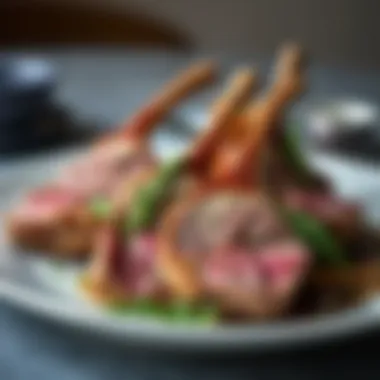
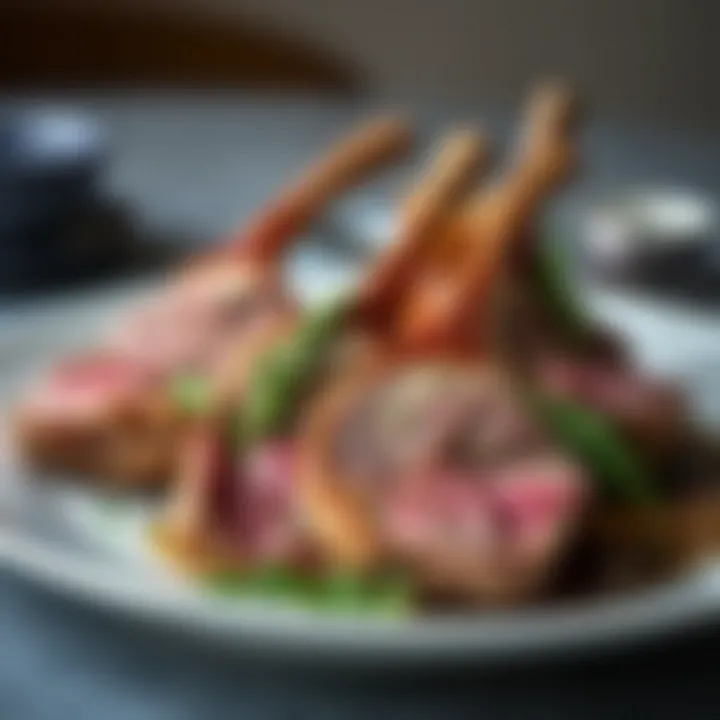
If overcooked, serve with a sauce or gravy to add moisture. For undercooked, continue cooking on lower heat until done.
In summary, leg of lamb steaks can be a showstopper at any dining experience. With a bit of knowledge and attention to detail, you can transform a simple cut into an extraordinary dish that resonates with flavor and finesse.
For more information on lamb and its culinary usage, check out Wikipedia and Britannica.
Explore community cooking tips on Reddit.
For deep dives on nutrition, refer to .gov sites.
Understanding Lamb Cuts
Understanding lamb cuts is crucial for anyone who aspires to prepare exquisite meals using this delicious meat. Not only does knowledge of the different cuts allow for informed decisions when purchasing, but it also enhances your cooking techniques and outcomes. Each cut of lamb has its unique qualities, textures, and flavors, which can significantly affect the final dis and dining experience.
The leg of lamb, specifically, offers a remarkable balance of tenderness and robust flavor, making it a prime choice for many traditional and modern dishes. Familiarity with lamb cuts can help you select the perfect piece for your culinary needs, whether you intend to roast, grill, or pan-sear.
Anatomy of the Leg of Lamb
The leg of lamb is a generous cut that includes the thigh, shank, and a part of the hip. By understanding its anatomy, one can appreciate not only how to cook it but also how to prepare it properly. The muscle structure is made up of several components:
- Thigh: This part is the meatiest, known for its tenderness. When cooked correctly, it yields rich, flavorful bites that are hard to resist.
- Shank: A bit tougher due to its heavy muscle use, the shank is great for slow cooking methods. It contributes deeply to the flavor profile of any stew or broth.
- Knuckle: This smaller section can be grilled, roasted, or braised and is often overlooked, yet it carries its own charm.
When buying a leg of lamb, consider asking your butcher to prepare it for you, whether that means removing the bone for easier cooking or trimming excess fat.
Differences Between Lamb Cuts
Choosing between lamb cuts can often feel like standing at a culinary crossroad. The differences between the cuts are often grounded in both texture and flavor:
- Shoulder: Known for its rich flavor, the shoulder cut is perfect for braising or slow roasting.
- Rack: The rack of lamb is seen as a showstopper, ideal for roasting, with its tender meat and elegant presentation.
- Loin: Another tender cut, the loin is perfect for grilling—it's juicy and can be cooked to perfection quickly.
- Flank and Breast: These cuts tend to be fattier and are best for ground lamb or slower cooking methods.
With so many options, understanding the cooking methods that suit each cut is essential for culinary success.
Benefits of Choosing Lamb Steaks
Lamb steaks are a fantastic choice for many reasons. They combine convenience with the unique, robust flavors that lamb is known for. Here are some notable benefits of choosing lamb steaks:
- Rich Flavor: Lamb steaks provide a deeper flavor that’s hard to replicate with other meats. This richness can elevate simple dishes into something special.
- Versatility: Whether you’re tackling grilling on a summer day or slow roasting in winter, lamb steaks adapt well to various cooking techniques, making them suitable for any occasion.
- Nutritional Value: Lamb is a source of high-quality protein, vitamins, and minerals, essential for a balanced diet. It's particularly rich in Vitamin B12 and zinc, which are crucial for overall health.
Investing in good-quality lamb steaks can transform your culinary landscape. You’re not just cooking; you’re enhancing your dining experiences with each preparation.
The Flavor Profile of Leg of Lamb
The flavor profile of leg of lamb is essential, as it encapsulates the unique essence of this meat. Understanding this flavor lands us in the middle of culinary adventures, where each taste can tell a story or transport us to a different time and place. The richness of lamb is often underrated. This cut stands out due to its robust flavor, which has a slight gamey quality. The meat tends to be tender yet firm, and its marbling adds an element of juiciness that can be simply delightful. When cooked correctly, lamb steaks can showcase a symphony of savory notes that dance across the palate.
Understanding the Richness
Delving deeper into the richness of leg of lamb requires knowing what sets it apart from other meats. The unique taste comes from the lamb's diet and upbringing. Grazing on lush pastures infuses the meat with flavors that are hard to find in beef or pork. In culinary terms, the richness refers to both the depth of flavor and the specificity of its taste—there's a distinct earthiness combined with a hint of sweetness.
When taste testing, one might note that there are variations depending on the specific breed of lamb, as well as their diet. For instance, lambs raised on a rich diet of clover or legumes can have pronounced flavor notes compared to those that consumed grass. This complexity means that cooking methods need to align with understanding flavors; for instance, pairing certain herbs and spices can accentuate chosen characteristics of the meat. Think rosemary, thyme, or even a hint of cumin—these can amplify the richness to even greater heights.
Natural Pairings and Enhancements
In exploring natural pairings, one finds that leg of lamb plays very well with various ingredients. Not only do herbs like rosemary and mint provide great companionship, but they also act as a counterbalance to the meat's natural richness:
- Herbs: Rosemary, mint, and oregano are classics. The freshness of these herbs cuts through the fat, making each bite a pleasurable experience.
- Citrus: Lemon and orange zest can brighten the heavier flavors, lending a refreshing twist, especially when grilled.
- Garlic: A staple for enhancing lamb, its pungency melds beautifully with the meat's earthiness.
Enhancements can also come through cooking techniques. For example, roasting can create a crispy outer layer while keeping the inside beautifully tender. This contrast allows the flavors to meld during the cooking process, leading to a final product that is flavorful and diverse in its taste profile. Also, don’t overlook the power of a good marinade; sending those encouraging flavors deep into the meat can ramp up the richness even further.
Preparation Techniques
Understanding the preparation techniques for leg of lamb steaks goes a long way toward enhancing the flavor and tenderness of this cherished cut. Well-prepared lamb steaks resonate on the palate, providing an experience that is savory and satisfying. These techniques serve not only to develop the inherent flavors of the lamb but also to create a connection between tradition and modern culinary practice.
Marinating for Maximum Flavor
Marinating is perhaps the most effective strategy for infusing leg of lamb steaks with flavor while also tenderizing the meat. A well-thought-out marinade can add depth to each bite, transforming a simple dish into something extraordinary. Combining oils, acids, herbs, and spices in a marinade allows the lamb to absorb various tastes that resonate with its natural profile.
When preparing a marinade, consider these key ingredients:
- Acid: This could be lemon juice, vinegar, or yogurt—anything that helps to break down proteins.
- Oil: Olive oil is a popular choice for its richness and ability to facilitate flavor absorption.
- Herbs and spices: Fresh rosemary, thyme, garlic, and black pepper can add aromatic qualities that complement lamb beautifully.
To maximize flavor, let your lamb steaks soak in the marinade for at least a couple of hours; ideally, overnight is best. Encapsulating the lamb in the marinade helps in creating a balanced flavor profile, one where the natural richness of the meat shines through alongside the additional seasonings.
Seasoning Essentials
Beyond marinating, seasoning leg of lamb steaks appropriately is crucial. The right balance of salt and spice can accentuate the-meat's savory characteristics. However, the nuances lie in the specific blends and their application.
Here’s how to get it right:
- Salt: A flaky sea salt or kosher salt amplifies flavors more effectively than table salt. It’s best applied a few hours before cooking, allowing the meat to absorb it deeply.
- Pepper: Freshly cracked black pepper adds a warmth that enhances the overall taste.
- Dry rubs: A blend of spices like cumin, coriander, and smoked paprika can create a crust that lends a unique flavor to the lamb.
Incorporate your spices on both sides of the steaks, but be careful not to over season; a little can go a long way. Use a light touch at first; you can always add more if needed.
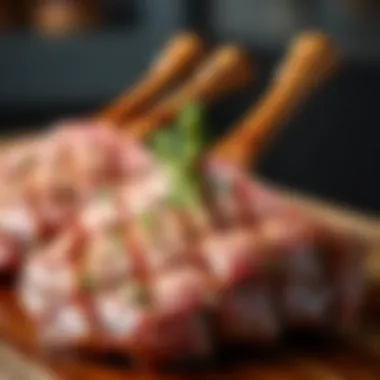
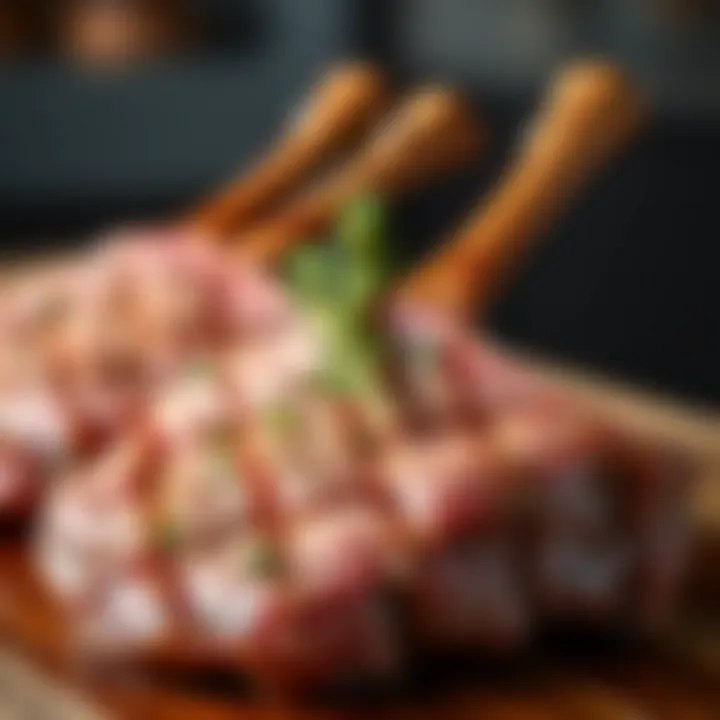
Cutting and Slicing Techniques
Once the leg of lamb steaks are cooked to perfection, how they are sliced makes a significant impact on texture and ease of eating. Slicing against the grain helps break up the muscle fibers, allowing for a tender bite. Conversely, cutting with the grain results in tougher pieces that are harder to chew.
To achieve optimal slices:
- Identification of the grain: Before you carve, take a moment to observe the direction of the muscle fibers.
- Proper resting: Allow the lamb to rest for a handful of minutes post-cooking. This redistribution of juices keeps the meat moist once it’s cut.
- Using a sharp knife: A sharp carving knife will ensure clean cuts and minimal shredding.
- Thin slices: Aim for slices that are around half an inch thick. This thickness promotes juiciness and maximizes flavor with every bite.
"A little knowledge in preparation goes a long way in ensuring each dish isn't just a meal, but a culinary journey."
Using these preparation techniques, you're setting the stage for a truly remarkable dining experience centered around leg of lamb steaks. Cooking isn't just a task; it’s an art, and the techniques discussed here are your brushstrokes.
Cooking Methods for Leg of Lamb Steaks
The cooking method you choose for leg of lamb steaks makes all the difference in bringing out their rich flavors and textures. Each technique can transform this cut of meat into something special, whether it’s juicy and tender or boldly charred. Understanding the nuances in cooking methods not only enhances the dining experience but also elevates your culinary skills. This section will explore different cooking techniques that showcase the leg of lamb, touching on their unique advantages and considerations.
Grilling: Achieving the Perfect Char
Grilling lamb steaks is a favored method that results in an unbeatable char and smoky flavor. With the right approach, you can strike a balance between a perfectly seared exterior and a juicy interior. Start with preheating your grill to a medium-high temperature, around 400 to 450 degrees Fahrenheit.
Before placing the steaks on the grill, it’s wise to let them come to room temperature, ensuring a more even cook. Season simply with salt and pepper or a marinade to enhance natural flavors. As they cook, resist the urge to flip them too often; letting them rest on the grill allows those beautiful grill marks to form. Aim for about eight to ten minutes per side, depending on thickness, for medium-rare doneness.
"The perfect grilled lamb steak is not just about time on the heat, but the love put into preparing it."
Roasting: A Traditional Approach
Roasting lamb steaks can seem a bit old-fashioned, but that doesn’t diminish its effectiveness. It’s a method that allows the meat to cook evenly while developing depth in flavors. Preheat your oven to around 325 degrees Fahrenheit, providing a slow and steady environment for your lamb.
Prior to roasting, it’s advisable to sear the steaks in a pan on the stovetop. This locks in juices and creates a crust that enhances flavor. Then, transfer the pan to the oven for about 20 to 30 minutes, depending on the thickness. Use a meat thermometer to gauge doneness, aiming for an internal temperature of 135 degrees for medium-rare. You can also toss in vegetables around the lamb for a one-pan meal; rosemary and garlic pair exceptionally well.
Pan-Sealing: Quick and Flavorful
For those looking for quick cooking techniques without skimping on taste, pan-sealing is the way to go. This method combines the techniques of searing and finishing in a shorter timeframe without sacrificing flavor. You start by heating a heavy skillet over high heat until it’s nearly smoking.
Add a splash of oil to the pan, and let it shimmer. Place the lamb steaks and let them sear until they get a golden crust, which should take roughly 3-4 minutes on each side. After browning, you can lower the heat and add a splash of broth or wine to deglaze the pan. Covering the pan allows the meat to finish cooking while capturing all those delicious flavors in the juices.
Sous Vide: Precision Cooking
Sous vide cooking has revolutionized how ribs, steaks and, of course, lamb are prepared. This method involves sealing the meat in a vacuum-sealed bag and immersing it in hot water at a controlled temperature. The sous vide technique allows for an even cook throughout, delivering tender and juicy results intersecting perfectly with meat lovers’ desires for precision.
Set the water bath to about 130 degrees Fahrenheit for medium-rare, and leave the lamb steaks in for 2-4 hours. Following the sous vide process, a quick sear on a hot pan creates an inviting outer crust, while the middle remains uniformly cooked and exquisitely tender. It’s a bit high-tech, but it transforms meat into something extraordinary.
In understanding these various cooking methods, one must remember that each has its place based on personal preference, occasion, and time constraints. With a mastery of these techniques, your leg of lamb steaks will not only taste phenomenal but also bear the hallmark of a chef’s touch, impressing family and friends alike.
Serving Suggestions
When it comes to leg of lamb steaks, the serving suggestions can truly make or break the dining experience. Elevating your dish involves much more than just throwing a steak on a plate. It's all about harmonizing flavors and presenting a visually appealing meal that entices the palate. Here, we'll delve into accompaniments, side dishes, and sauces that will take your lamb experience from ordinary to extraordinary.
Accompaniments That Enhance Flavor
Selecting the right accompaniments can increase the enjoyment of lamb steaks significantly. Lamb, with its rich and distinctive taste, pairs beautifully with various sides that complement its flavors.
- Seasoned Vegetables: Roasted root vegetables such as carrots, parsnips, or beets can add a hint of sweetness and earthiness. Toss them with olive oil, salt, and fresh herbs before roasting for a flavorful crunch.
- Grains: Dishes like herbed couscous or creamy polenta bring a contrasting texture to the tender meat. The grains soak up juices and sauces, creating a cohesive bite.
- Salads: A light arugula or mint salad can provide a refreshing counterpoint. Feta crumbles and a drizzle of lemon vinaigrette can enhance the lamb without overpowering it.
"A good meal is like a symphony; every note matters."
Ideal Side Dishes
The side dishes you select can make a substantial difference in your meal's overall balance. Here are some ideas to consider:
- Garlic Mashed Potatoes: Creamy, buttery mashed potatoes infused with roasted garlic can set the stage for a satisfying bite, blending perfectly with the lamb's richness.
- Grilled Asparagus: This green addition adds visual appeal and a pleasant crunch that contrasts beautifully with the tender lamb.
- Ratatouille: This classic French dish of stewed vegetables is not only colorful but also enhances the meal with layered flavors, bringing depth to your plate.
- Mint Yogurt Sauce: A cool, tangy yogurt sauce can cut through the lamb's richness, helping to awaken the palate.
Creative Sauces and Condiments
Enhancing leg of lamb steaks with the right sauces can elevate your dining experience to new heights. Here are some notable options:
- Red Wine Reduction: A rich reduction made from red wine adds complexity and depth, with flavors that complement the meat wonderfully.
- Chimichurri: This herby Argentine sauce, made with parsley, garlic, and vinegar, brings a zesty brightness that contrasts expertly with the lamb’s flavor.
- Dijon Mustard Glaze: A simple spread of Dijon mustard coupled with honey can add a touch of sweetness and sharpness that plays well with the meat.
- Pesto: A vibrant basil pesto can bring freshness and herbal notes that marry beautifully with the lamb.
Using these suggestions, you can build a meal that is not only aesthetically pleasing but also rich in flavor. Remember, the art of serving is to create a multisensory experience that invites guests to savor every bite.
Pairing Wine with Lamb
Pairing wine with lamb is an essential aspect of culinary enjoyment that cannot be overlooked. Lamb, particularly leg of lamb steaks, has a rich and distinct flavor that can be either enhanced or overshadowed by the choice of wine. Getting this pairing right contributes to the overall dining experience, making it both more pleasurable and memorable. The complexities of lamb’s flavor profile—ranging from earthy undertones to hints of sweetness—call for wines that can complement or contrast these characteristics effectively.
Here, we will dive into the various elements to consider when selecting wine for this exquisite dish, showcasing how proper pairings can elevate a meal from simply good to extraordinary.
Understanding Wine Profiles


To understand how to successfully pair wine with lamb, it’s important to recognize different wine profiles. A wine's profile includes its aroma, flavor, acidity, and body. Here are some general considerations:
- Aroma and Flavor: Rich, robust wines often pair better with lamb, particularly reds high in tannins. Fruity notes can bring out the sweetness in the meat.
- Acidity: Higher acidity can cut through the richness of lamb, cleansing the palate. This is crucial when enjoying fattier cuts.
- Body: Full-bodied wines often complement the deep flavors of lamb, while lighter wines might be overshadowed by the meat’s intensity.
Understanding these elements allows you to choose wines that harmonize well with lamb's distinctiveness, creating a balanced and enjoyable meal.
Red Wine Recommendations
When it comes to pairing red wine with lamb, the options are as rich as the meat itself. Here are a few standout recommendations that can make a significant difference to your dining experience:
- Cabernet Sauvignon: A robust choice, Cabernet Sauvignon delivers rich tannins and bold flavors. Its dark fruit notes can stand up to the boldness of lamb.
- Syrah/Shiraz: Known for spicy and smoky notes, these wines offer a fantastic balance to lamb steaks, especially when grilled.
- Merlot: For a softer, fruitier option, Merlot can complement the meat quite nicely. Its smooth texture makes it a crowd-pleaser.
- Malbec: With its earthy undertones and acidity, Malbec is another excellent option, particularly for rich and slow-cooked lamb dishes.
- Tannin-Balanced Wines: Look for wines that offer a gentle balance of tannins. They can bring out the meat’s nuances without overpowering.
A good rule of thumb is to think about the specific preparation method and seasoning used. For instance, grilled lamb might benefit from a Syrah to highlight the char marks, while a rosemary-infused lamb could be better suited to a Malbec.
The right wine can turn a good meal into a memorable feast, amplifying the flavors and creating an experience that lingers long after the last bite.
When you make the effort to understand the profiles of these wines and the specific cuts of lamb, your culinary explorations become even more rewarding, satisfying both the palate and the spirit.
Cultural Significance of Lamb
The cultural significance of lamb transcends kitchen boundaries and touches the very heart of numerous traditions around the world. From ancient rituals to modern celebrations, lamb has held a weighty presence in various cuisines, often symbolizing abundance, health, and prosperity. This article explores the rich tapestry of lamb consumption, focusing on its historical importance and the exquisite dishes that create a connection among diverse cultures.
Historical Context Through Cuisine
Throughout history, lamb has been a central figure in numerous culinary traditions, serving not just as sustenance but as a cultural emblem. In many ancient civilizations, lamb was intertwined with rituals and religious practices. The ancient Egyptians revered the lamb, connecting it to their gods and using it in sacred offerings. Similarly, in the Jewish tradition, lamb plays a pivotal role during Passover, symbolizing liberation and sacrifice.
In Europe, particularly in Mediterranean countries, lamb has been associated with feasting and celebration. Take, for example, Greek Easter, where roasted lamb often takes the stage. The lamb symbolizes spring and renewal, perfectly complementing the joyous atmosphere. In fact, many historical texts, from Homer to medieval cookbooks, extol the virtues of lamb, emphasizing its tender meat and flavor.
As we navigate through time, the cultural significance of lamb persists, adapting to various contexts without losing its essence. Understanding these historic connections enhances our appreciation for lamb today and allows food lovers to respect the cultural practices surrounding its consumption.
Celebratory Dishes In Various Cultures
Celebratory dishes featuring lamb are where culinary creativity and tradition meet. Different cultures have their unique ways of preparing lamb that reflect their heritage and values. Here are a few notable examples:
- Mouton de Panurge: In France, a rustic lamb dish typically prepared for special occasions, often served with garlic and herbs, highlighting the rich flavors of the meat.
- Biryani: In South Asian cultures, lamb biryani is a festive dish, fragrant with spices and often served during weddings and holidays, symbolizing hospitality.
- Tagine: In Moroccan cuisine, lamb tagine brings warmth to gatherings with stewed meat and vegetables, cooked slowly to meld flavors, showing the essence of comfort food.
By exploring lamb through these various celebratory dishes, it's clear that the meat not only nourishes the body but also nurtures cultural connections. It invites communities together, honoring both heritage and innovation. Each dish tells a story, showcasing the flavors and traditions of its people.
"Food is a universal language. Each bite of lamb carries with it centuries of history and tradition, making every meal a heartfelt connection to the past."
In sum, examining the cultural significance of lamb allows for a deeper understanding of its role beyond mere sustenance, solidifying its place in history and the narratives woven by different cultures around the world.
Sustainability in Lamb Farming
Sustainability in lamb farming is a critical aspect that shapes not just the future of the industry, but also the environment and our culinary experiences. As consumers become more aware of where their food comes from, the importance of ethical sourcing and environmental stewardship is being recognized as a vital part of producing meat that is not only delicious but also responsibly obtained.
The Importance of Ethical Sourcing
Ethical sourcing involves obtaining lamb from farms that prioritize animal welfare, environmental care, and social responsibility. This means fostering practices that ensure the animals are treated humanely and raised in a sustainable manner. Here are key elements of ethical sourcing in lamb production:
- Animal Welfare: Ensuring that lambs are raised with adequate space, proper nutrition, and health care.
- Local Supply Chains: Sourcing lamb from local farms supports the community and reduces the carbon footprint related to transportation.
- Transparency: Consumers are more inclined to choose products where they can trace the meat back to its source. Knowing how and where the lamb was raised is invaluable.
By choosing ethically sourced lamb, consumers contribute to a system that respects both the animals and the ecosystems in which they are raised. This, in turn, leads to healthier meat products and a more resilient food system.
Environmental Considerations
Lamb farming comes with its own set of environmental challenges. However, if managed sustainably, it can lead to positive outcomes. Some considerations include:
- Proper Land Use: Responsible grazing practices help restore soil health and biodiversity. Farmers can employ rotational grazing, allowing pasture to recover and minimizing overgrazing.
- Carbon Footprint: When lamb farms incorporate sustainable practices, such as reducing reliance on synthetic fertilizers and utilizing renewable energy sources, the overall carbon emissions associated with production decrease significantly.
- Biodiversity: Sustainable farming can enhance local ecosystems. Integrating livestock into farmland can lead to better pest control and promote plant diversity.
"Sustainable lamb farming is about striking a balance between production, environmental stewardship, and ensuring that the welfare of the animals is respected."
Epilogue
Wrapping up our exploration of leg of lamb steaks, it's clear that this cut of meat holds a prominent place in culinary traditions and modern kitchens alike. Understanding the facets of lamb from its anatomical structure to the cooking methods available empowers chefs and home cooks to savor and appreciate this exceptional ingredient.
Recap of Key Insights
We’ve journeyed through several essential aspects:
- Understanding Lamb Cuts: Grasping the anatomy of lamb offers insights into the quality and flavor you can expect from different cuts, especially the leg. Knowing how to differentiate between lamb cuts aids in making informed choices when purchasing meat.
- Flavor Profile: The distinct richness of leg of lamb, balanced with its versatility in pairings, makes it a culinary favorite. Our discussion on natural enhancements provides avenues to elevate each dining experience.
- Preparation and Cooking Techniques: We explored various methods—grilling, roasting, and sous vide—each bringing out unique flavors and textures in the meat. Mastering these techniques is vital for anyone looking to create gourmet meals at home.
- Culinary Context: The cultural significance of lamb transcends meals; it connects traditions, celebrations, and sustainability. This dimension enriches the dining experience beyond mere taste.
- Sustainability Matters: Ethical considerations and sourcing practices promote a responsible approach to meat consumption. Making conscious choices is not just about health; it’s about respecting our planet.
In essence, leg of lamb steaks are more than just an item on a grocery list. They represent a tapestry of flavors, techniques, and cultural narratives that resonate with food enthusiasts.
Encouraging Culinary Exploration
To truly appreciate the depth of flavor that leg of lamb offers, one must venture beyond basic cooking. Experimentation is key. Try different marinades, from robust garlic and rosemary to citrus-infused blends. Engage with diverse cooking methods to discover personal preferences in texture and taste. Embrace contemporary culinary innovations such as pairing unexpected sides or crafting flavorful sauces that complement the inherent richness of lamb.
Engage in local markets or farms to learn about sustainable practices and enquire about the best cuts. Traveling to regions where lamb has a historical context can also inspire new ideas for preparation and presentation.
In the spirit of culinary adventure, explore recipes from around the world. Each culture offers a unique perspective that can add a distinctive flair to your own cooking. From Mediterranean flavors to East Asian influences, the options are plentiful.
In summary, investing time into understanding and cooking with leg of lamb opens doors to a world of flavors and experiences that is worth exploring. Bon appétit!





